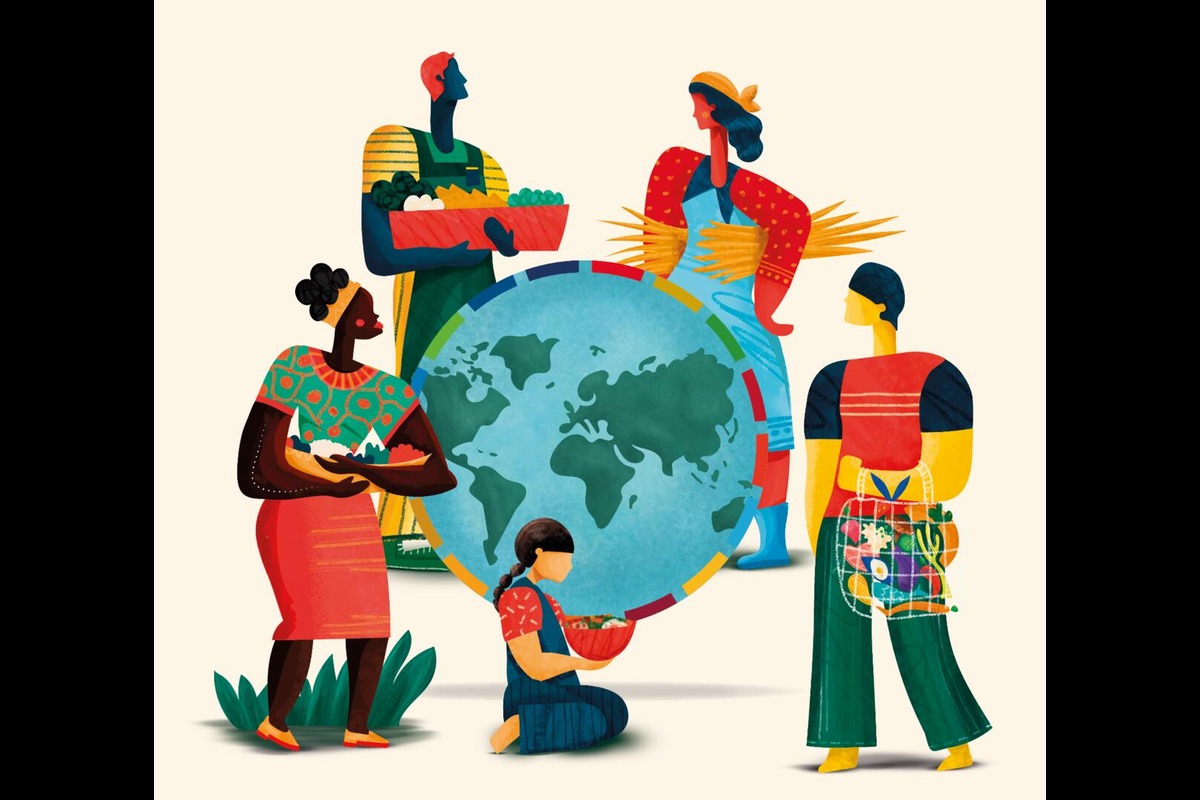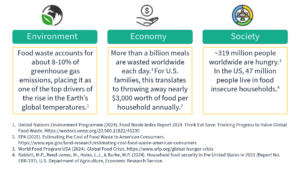CFCWR Blog

One Day, One Big Goal: International Day of Awareness of Food Loss and Waste
Written by: Mateo Dasso, CFCWR Student Intern, Purdue University
Did you know that over a third of the food available in the U.S. is being thrown away as waste? Just imagine going to a grocery store and buying three bags of groceries, only to throw one entire bag straight into the trash. Now, picture the same scenario, but instead of throwing it away, you give it to someone who needs it or change the way you store it to ensure you use it before it goes bad. Which scenario would make you feel better? I’m guessing you said the second, right?
For most of us, we think we are throwing away small amounts of food, so what’s the harm? That expired milk in your fridge, those forgotten leftovers, that slightly bruised apple you threw away — multiply that by millions of U.S. households, and you’ve got a crisis hiding in plain sight.
That’s why September 29 is a very important day on the calendar. It marks the International Day of Awareness for Food Loss and Waste. The reason this day was established is simple yet important – it serves as a reminder to the world that food loss and waste are a global crisis, and we need collective action to create significant change.
Through this post, we will explore what this day represents, the value and importance of reducing food loss and waste, and what we can do at home and in our communities to help reduce this problem. When it comes to food, every bite matters, and conserving food brings us closer to a healthier planet and a better future.
A Day of Awareness
The International Day of Awareness for Food Loss and Waste is an annual global call to action from the United Nations (UN) Food and Agriculture Organization (FAO) and UN Environment Programme (UNEP). This year’s theme gets straight to the point – reducing food loss and waste is key to a sustainable future. Therefore, this is more than a day in the calendar. Instead, it serves as a reminder of how food loss and waste are directly linked to some of the major planetary problems we face, such as hunger, environmental damage, and the misuse of natural resources.
This annual event reminds us that change is not only possible but also strategically important for the health of people and the planet. The UN has set an ambitious target through Sustainable Development Goal 12.3, which aims to reduce food waste and loss by half by 2030. That’s just 5 years away! To achieve this goal, businesses can innovate ways to reduce losses throughout the supply chain, governments can promote incentives and policies, and households, as the end consumers, can make small daily changes that yield big results.
This annual event isn’t about guilt-tripping anyone who’s ever forgotten leftovers in the fridge. Instead, it’s a rallying cry that connects the dots between your kitchen and some of humanity’s most pressing challenges.
Importance of Reducing Food Loss and Waste
Food waste is not only about wasted meals – it’s about wasting so much more. It is helpful to consider the impacts from multiple angles. Looking at this issue from the environmental, economic, and societal perspectives makes it easier to understand how this issue affects the planet, our money, and our lives. Here’s what’s really at stake:

Bottom line…Conserving food and reducing waste is not only beneficial for the environment, our natural resources, and our wallet, but also helps achieve a fair food system for the betterment of future generations.
What can you do as a household?
Collectively, household food waste in the U.S. accounts for ~35% of all food waste. Therefore, if every U.S. household made a few changes to conserve food, the impact would be enormous. Here are a few tips:
- Plan your shopping – create meal plans and shopping lists to know what you are going to consume and avoid buying more than what you need. You can check our website for ideas.
- Include apps and platforms – apps such as Misfit Markets help you buy “imperfect” looking produce that would otherwise go to waste. Other apps, like Olio, Flashfood, and Too Good to Go, help you connect with surplus food at discounted prices.
- Food storage – check your refrigerator, freezer, and pantry or cabinets regularly to use food before it goes bad. Keep track of expiration dates and learn proper storage techniques for different foods.
- Reuse food – Transform last night’s dinner leftovers into today’s lunch or use them as ingredients for new meals.
Check out our Resource Library for more info about these tips – plus many more food conservation resources!
Beyond the household
The fight against food loss and waste goes far beyond the household.
- Governments — play a vital role in launching campaigns, rules, and targets, and implementing incentives for businesses to reduce surplus and encourage donation. Learn more about food waste reduction policies & legislation at the federal, state, and local levels. Several European countries have also enacted legislation aimed at reducing food loss and waste. As an example, read about regulations in France requiring food donation by large supermarkets.
- Communities — can create incentives like neighborhood composting projects or apps that connect nearby households to share surplus food. These efforts not only strengthen the community, but more importantly, they will help create daily sustainable practices.
- Businesses — from the farm to the plate, supply chain improvements in transportation methods, storage, and packaging can also help reduce food loss and waste.
Conclusion – The time is now
Food loss and waste are more than everyday problems; they are a global threat that relates to the world’s most pressing issues: environmental degradation, hunger, and dwindling natural resources. This is a call to everyday citizens, as well as governments, communities, and the entire food supply chain, to change how we value food.
September 29 is our chance to make a change. So, spread awareness with your family, friends, and community to support local incentives and start making small changes at home that will add up to a bigger impact. The choice is ours, and the time is now.
This work is supported by the Agriculture and Food Research Initiative, project award no. 2024-68015-42110, from the U.S. Department of Agriculture’s National Institute of Food and Agriculture. Any opinions, findings, conclusions, or recommendations expressed in this publication are those of the author(s) and should not be construed to represent any official USDA or U.S. Government determination or policy.
